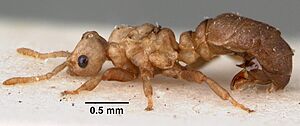Tetramorium atratulum facts for kids
Quick facts for kids Tetramorium atratulum |
|
|---|---|
 |
|
| T. atratulum male | |
| Conservation status | |
| Scientific classification |
Tetramorium atratulum is a special kind of ant. It's rare and lives as a parasite, meaning it depends on other ants for survival. It's found in Europe and Asia (the Palaearctic region) and has also spread to North America. This ant is very unique because it doesn't have worker ants. Only females and special males exist. Their bodies are built in a way that shows they are highly adapted to being parasites.
The males of T. atratulum have pale bodies and thin skin. Their body parts like the petiole (a narrow waist-like segment) and postpetiole (the next segment) are widely connected. They also have very small mandibles (jaws), palps (sensory feelers), and antennae. Female ants have fewer veins in their wings and a narrower back of the head. Adult females are usually swollen with eggs and are found inside the nests of their host ants, which do not have their own queen.
Unlike many other parasites, T. atratulum never lives in a nest that has a fertile queen of the host ant species. This means that every T. atratulum colony can only survive as long as the youngest host workers live. This time is often only two to three years or even less. Because of this, the parasitic queen has a very short time to produce new winged ants to start the next generation. This is why T. atratulum is very rare, even in places where it is known to live. Only a tiny number of Tetramorium ant colonies host this parasite.
Where do Tetramorium atratulum ants live?
These ants are found in specific areas across Eurosiberia (Europe and Siberia) and the eastern parts of North America. Their distribution generally follows where their host ants live. They are present but not common in the southern parts of Great Britain. They were first found in the UK on July 23, 1912, in the New Forest by H. St. J. K. Donisthorpe and W. C. Crawley.
Which ants do Tetramorium atratulum parasitize?
T. atratulum has mainly been found in the nests of Tetramorium caespitum and T. impurum. Recently, it was also found in a nest of T. immigrans. These three host species are all part of a group called the Tetramorium caespitum/impurum complex.
It was also recorded in Sicily, Italy, at a low elevation (300 meters) in a nest of T. diomedeum. This host ant is a member of the Tetramorium ferox complex. Scientists believe that as they learn more about the complicated groups of Tetramorium ants, they will likely find even more host species that T. atratulum parasitizes.
One report by Schulz & Sanetra (2002) mentioned T. chefketi as a host. This was an update to earlier findings from Tavşanlı, Turkey. Tetramorium moravicum was also suggested as a possible host by Sanetra & Buschinger (2000), but without more details.


